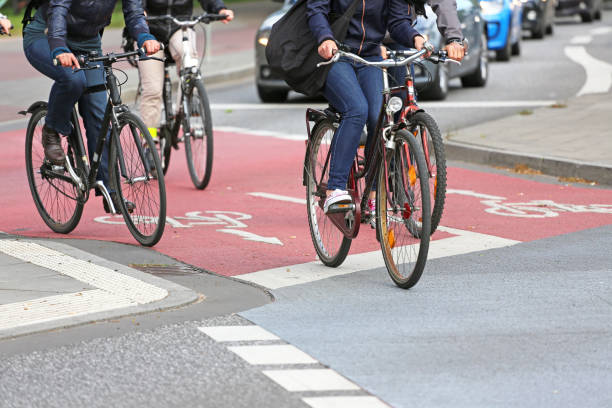
By Karen Piso Nadeau, Esquire
Our law firm is located in the heart of Cambridge, Massachusetts in Harvard Square. Whether traveling through Cambridge, Massachusetts in a car or walking the city, it is easy to see that many people in Cambridge, Massachusetts choose to use a bicycle to get around. Cycling offers convenience, exercise and an economical way to travel. In addition, bicycling reduces pollution and addresses climate change. The hustle and bustle of the lively city of Cambridge, Massachusetts inevitably has many motor vehicles, public transportation, bicycles and pedestrians traveling together on the city roads leading to the increased risk of serious personal injury from accidents, many which could have been avoided with proper care and attention to the surroundings.
Bike Lanes in Cambridge a Source of Controversy
According to wickedlocal.com, bike lanes in Cambridge are one of the most controversial subjects in the city. Some residents feel the city should do all it can for environmentally friendly mode of transportation. Others feel bike lanes have gone too far by removing parking and creating narrower roads. Some have voiced objections saying there is more room for bicyclists and less room for drivers and argue the cyclists should pay insurance like motor vehicle operators.
What are Bike Lanes and Why are they Important?
Bicycle lanes are marked lanes in the public right-of-way that are by law exclusively for use by bicyclists. Bike lanes in Cambridge have bicycle symbols and arrows, showing the correct direction of travel. Motorists are not allowed to travel in bike lanes and are subject to a $100 fine if they do so. They are allowed to cross the lanes to turn or to park. Cyclists are still permitted to travel in the regular vehicle travel lanes even when a bike lane is present. Cyclists should signal and make sure they have the attention of the people behind them before moving into the vehicle travel lane from a bike lane. Motorists should be aware that cyclists may merge into their lanes in front of them to avoid an obstacle or to make a left turn for example. Bike lanes make city streets safer for everyone.
Bike lanes support and encourage bicycling as a means of transportation and gives bicyclists a clear place to be. The bike lanes remind motorists that cyclists have a right to the road. The bike lanes help define road space and decrease stress for bicyclists. The most important way to promote bicycle transportation is to provide a safe place where bicyclists can ride.
Bike lanes have improved safety in terms of both number and severity of crashes in cities throughout the United States. Also, cyclists practice safer bicyclist behavior. Cyclists are more obedient to traffic controls and there is less wrong way and sidewalk riding.
The premise of Cambridge bicycle transportation planning is that all roads are bike ways. All streets in the city are places where safe bicycling should be enabled. This is important because many destinations are located along major streets such as stores, schools and restaurants.
What are Separated Bike Lanes and Why Do They Increase Safety?
A separated bike lane refers to a bicycle facility with a physical separation from the motor vehicle travel area, often through barrier or grade separation. They are protected bike lanes typically located between the street or parking lane and pedestrian sidewalk.
Research shows that separated bicycle lanes increase safety, supporting the city’s goal of creating more equitable transportation opportunities for people of all ages and abilities. The benefit is reduced crashes and decreased overall injury risk and fear of collision.
The city of Cambridge was one of the first cities in the United States to design and construct separated bike lanes. There are a number of separated bike facilities in Cambridge. See Cambridge CDD
Bike Crashes Resulting from Motor Vehicles and Bicycles Sharing the Roadways in Cambridge
The most common types of bicycle-motor vehicle crashes in Cambridge are:
-Motor vehicle entering a main street from a side street hitting a cyclist
-Motorist opening a car door in front of a bicyclist
-Motor vehicle turning left in front of a straight moving cyclist.
Other dangers for bicyclists are:
-vehicles sideswiping cyclist often when parking or leaving a parking space
-vehicles turning right in front of a straight moving cyclist.
Most crashes are the result of driver inattention.
Cambridge Police confirm that the total number of crashes in the city has declined since early 2000’s even as populations and number of road users have increased. However, crashes involving cyclists increased by 28% from 2000 to 2015 corresponding with increase bike ridership.
The Cycling Safety Ordinance
Cambridge City Council passed the Cycling Safety Ordinance in April 2019 with a commitment to build permanent bike lanes whenever improvements are made to streets including the city’s 5-year sidewalk and street reconstruction plan. The bill requires protected bike lanes on all city streets. The passage of this bill identifies the city of Cambridge as one of the most-progressive safe-biking cities in the country. The city cycling ordinance requires city streets to be upgraded to include the safest bike paths whenever a roadway is reconstructed.
Mayor Marc McGovern said in a statement that the Cycling Safety Ordinance codifies a lasting commitment to the users of roadways that Cambridge intends to have a modern, safe and accessible network of separated bicycle lanes for all residents regardless of their age or ability. Cambridge Bike Safety, a bike advocacy group, planned to lobby the city to adjust its construction schedule to increase the pace of change on streets included in the city’s bike plan.
City Councilor Dennis Carlone said Cambridge was the 4th most dense city in the country making bicycle use most appropriate in the city. Some believe the ordinance will place the city of Cambridge on par with some European leaders on infrastructure and ridership.
Tragic Death of Cambridge Bicyclist in August Reinforces the Need to Decrease the Dangers of Cycling on the City’s Streets
The Boston Globe reported on August 18, 2020 that a bicyclist who died in a collision with a tractor trailer near Harvard Square was a grim reminder for community activists and cycling advocates who long call for safer streets. Jan Devereux, former Cambridge City Councilor, noted that Harvard Square is old, narrow and congested and 18 wheelers were not designed to come through that space.
The truck struck an older man on a bike near the intersection of Massachusetts Avenue and Dunster Street, a short distance from the MBTA Red Line at Harvard Square. The truck was traveling on Mass Avenue away from Harvard Square toward Johnston Gate, the entrance of Harvard Yard. This death was the sixth bike fatality in 2020 according to the executive director of the nonprofit Mass Bike. In 2019, there were six bicycle fatalities for the year in Cambridge.
The increase in bicycle fatalities was partly attributable to the change in bicycle habits during the pandemic. Also, it was noted that too many highways and streets force big trucks and bicyclists into the same lane. Statistics show cycling deaths from crashes with motor vehicles largely on the rise in Massachusetts since 2013. In 2013, there were 6 fatalities; in 2014 there were 8; 2015 there were 12; and 2016 there were 10 according to Massachusetts Strategic Highway Plan.
A pedestrian fatality occurred less than a year before the August 2020 bike fatality in nearly the exact same spot when a large boom truck struck a pedestrian. According to the Harvard Crimson, in September 2019, 67 year-old librarian Sharon Hamer was struck and killed by a truck as she was crossing the street. Harvard Square is almost always full of pedestrians and cyclists crossing the irregular intersections.
Bicyclist Fatality Leads To Fast Tracking the City’s Cycling Plan
In early October 2020, Cambridge City Council voted to fast track the city-wide protected bike lane network and set a 2026 deadline for protected bike lane projects. City councilors noted how a truck driver killed a Cambridge resident Darryl Willis in an unprotected bike lane in Harvard Square in August. The new ordinance aims to accelerate construction of the city’s protected bike lane networks with a May 2026 deadline for most projects. Special consideration was given to Massachusetts Avenue for protected bike lanes.
The new layout includes widened bike lanes with flexible post bollards on Massachusetts Avenue in Harvard Square. This was implemented following the death of Darryl Willis who was struck and killed riding his bike without physical protection.
Protected bike lanes save lives by preventing almost 40% of crashes including doorings, sideswipes and front and rear collisions. Most protected bike lanes in the network will be required to be built in about 6 years by May 1, 2026.
Notable “hot spots” in Cambridge are along Massachusetts Avenue from MIT to Central Square, Harvard Square area, Mass Ave near Porter Square area and Inman Square area according to Cambridge Police.
Recommendations for Safe Travel
The City of Cambridge Watch for Bikes Brochure offers the following advice for those operating motor vehicles on city roads:
Look before turning
Look before opening a car door
Look before entering a main street
Look before proceeding from a driveway or side street.
As for those cycling, they should be aware of their surroundings and other road users.
Also, cyclist must yield to pedestrians at crosswalks and share paths.
Also, cyclists should have lights at night so people can see them.
In Massachusetts, all bicyclists must obey all traffic laws including red lights, stop signs and ride with traffic. All bicyclists are expected to stay to the right of the roadway except for left hand turns or where bike lane directs otherwise.
Cambridge discourages riding bicycles on sidewalks and pedestrians have the right of way on all sidewalks.
What are the Driver’s Responsibilities Sharing the Road with Cyclists?
As a driver,
– Do not block the bike lane
– Watch for bikes when turning
– Look for bikes and yield to bikes when entering or exiting driveways or when turning at intersections.
Safety Tips for Cycling
Cambridge Bicycle Safety highlights 5 safety tips for urban cycling as follows:
1. Ride cautiously and slowly. Stop at lights and yield to pedestrians.
2. Be visible. Use front and back lights.
3. Avoid large vehicle blind spots. Buses and trucks haver large blind spots on either side and front and back. Try to stay out of blind spots. If you cannot see the mirrors, driver likely can’t see you.
4. Avoid doors. Try to ride as far from parked cars as possible.
5. Pass another person riding on the left.
Finally, commit to follow the Street Code whether you are a bicyclist, pedestrian, vehicle operator, or public transport.
The Cambridge, Massachusetts Street Code is:
1. Slow down.
2. Put yourself in someone else’s shoes. Don’t assume the worst.
3. It is about all of us. All of us are trying to safely get somewhere.
When a bicyclist is injured in an accident with a motor vehicle, a thorough investigation of the accident events is necessary to determine the cause of the collision and secure important information. As a victim of a bike accident, make sure everything is done to protect your interests. The lawyers at Nadeau Harkavy LLC, located in the heart of the City of Cambridge in Harvard Square, help bike victims and their families recover damages for their losses in serious injury and wrongful death cases arising from bicycle accidents throughout the state of Massachusetts. If you have any questions about your legal rights relating to a bicycle accident, wrongful death or other accident, feel free to contact us for a free consult today at 617-674-7640.
Meet The Lawyers
With 60 years of combined experience serving injured victims in Massachusetts, our team has collaborated for nearly two decades, delivering a proven track record of outstanding results for clients. Guided by a philosophy of treating clients as we would our own family, we strive to ease our clients' journey from the initial phone call to case resolution. Committed to competing and fighting vigorously, we aim to hold insurance companies accountable to the fullest extent of the law. Our belief in close communication ensures the best possible outcomes, and our approachability makes us readily available to you. Entrust us with your case, allowing you to focus on your physical, emotional, and financial recovery.
Massachusetts Personal Injury Lawyers
Massachusetts Personal Injury Lawyers with over 60 Years Combined Experience Representing Those Injured in Accidents.













